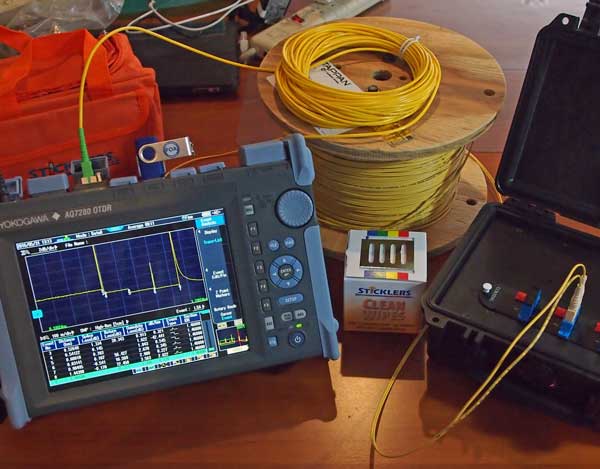Fibre testing equipment ensures precise measurements for multiple applications.
Wiki Article
The Role of Optical Fibre Testing in Ensuring High Quality and Effectiveness in Connectivity Solutions
In today's quickly evolving electronic landscape, the relevance of optical fiber testing can not be overstated, as it serves as a keystone for making certain the quality and performance of connection solutions. As modern technology proceeds to advance, the future of optical fibre screening poses fascinating obstacles and chances that warrant closer assessment.Relevance of Optical Fibre Testing
The value of optical fiber screening can not be overemphasized in making certain the integrity and performance of interaction networks. As the foundation of modern-day telecommunications, optical fibres promote high-speed information transmission, making their reliability critical to operational success. Evaluating functions as an aggressive procedure to recognize possible issues such as signal loss, attenuation, and physical damages, which can jeopardize network efficiency.Normal testing permits for the verification of installation quality and the detection of defects that can affect data honesty - robotic vision. By employing extensive screening methods, network drivers can minimize the risks related to network failures, including downtime and economic losses. Optical fiber screening guarantees conformity with industry requirements and guidelines, enhancing the total high quality of service offered to end-users.
Inevitably, the methodical assessment of optical fibers contributes to the durability and efficiency of interaction systems. It enables stakeholders to make informed decisions regarding upkeep, upgrades, and troubleshooting. In a landscape where information is progressively important, focusing on optical fiber screening is necessary to sustaining durable and effective connectivity remedies, consequently sustaining the demands of contemporary digital environments.
Kinds Of Optical Fibre Tests
Various screening techniques are utilized to make sure the capability and dependability of optical fibres within interaction networks. These examinations can be extensively categorized right into 2 main kinds: setup tests and upkeep examinations.Installation examinations are conducted quickly after the setup of optical fibre cable televisions to validate their performance and integrity - optical fibre testing equipment. One of the most usual installment tests consist of Optical Time-Domain Reflectometry (OTDR) tests, which analyze the quality of the fibre by determining mistakes or breaks, and end-to-end loss tests, which measure the overall optical loss from one end of the fiber to the various other
Maintenance tests, on the various other hand, are performed occasionally to ensure continuous performance and spot prospective issues in time. These consist of aesthetic examination, which checks for physical problems or incorrect installations, and continuity examinations, which verify that the signal can go through the fiber without disturbance.
Furthermore, advanced examinations such as Polarization Setting Diffusion (PMD) and Chromatic Dispersion (CD) tests can be carried out to evaluate the fibre's performance under various conditions. By using these diverse testing approaches, technicians can keep high criteria of high quality and reliability in optical fiber networks.
Advantages of Normal Testing
Normal testing of optical fibers plays a critical function in maintaining the overall efficiency and reliability of communication networks. By performing routine assessments, organizations can make sure that their fibre optic installations meet sector criteria and run efficiently. This aggressive approach assists to recognize prospective weaknesses and destruction with time, enabling prompt interventions before issues escalate.
Cost-effectiveness is an additional advantage. By dealing with small issues early, organizations can stay clear of the high expenses linked with significant repairs or system failures. Routine testing also fosters compliance with regulatory demands, guaranteeing that the network abides by needed security and performance criteria.
Common Issues Determined
Determining common problems in optical fiber networks is important for keeping ideal performance and reliability. Numerous aspects can add to interruptions, consisting of physical damages, bad installation techniques, and environmental influences.Physical damage, such as bends, breaks, or abrasions, can considerably break down signal high quality. Incorrect installation methods, including too much stress or insufficient protecting of cables, may cause raised attenuation and loss of connection. In addition, ecological variables such as temperature level variations, wetness access, and rodent disturbance can compromise the honesty of the fiber.
Connector issues also often emerge, with inappropriate alignment or contamination leading to raised insertion loss. Splicing mistakes can introduce significant signal degradation if not executed with accuracy.

Resolving these common problems with regular optical fiber screening not just improves network integrity but additionally optimizes total efficiency, guaranteeing that connectivity solutions stay durable and reliable.
Future Patterns in Checking
As the need for high-speed connection remains to climb, the future of optical fiber testing will progressively focus on automation and advanced analytics. The combination of man-made knowledge (AI) and maker learning (ML) in screening processes will certainly make it possible for a lot more reliable information evaluation and anticipating upkeep, reducing downtime and boosting general network reliability. Automated screening remedies will enhance the evaluation and certification of fibre networks, minimizing human error and raising screening throughput.One more substantial pattern is the fostering of remote screening innovations. As the deployment of fiber networks broadens right into remote and underserved locations, remote testing capacities will allow specialists to check and diagnose network conditions without physical existence, thereby decreasing operational prices and enhancing response times.
Moreover, there will be a shift towards more detailed testing requirements that encompass not just traditional loss measurements however additionally performance metrics such as latency and transmission capacity application. This alternative approach will help with better network monitoring and optimization techniques.
As these fads evolve, the optical fibre screening landscape will not only improve the high quality and effectiveness of connectivity options yet also sustain the expanding intricacies of contemporary communication networks.
Final Thought
To conclude, optical fiber testing serves as a fundamental part in maintaining the stability and efficiency of communication networks. By methodically evaluating numerous specifications through developed screening approaches, possible concerns are identified and corrected, ensuring optimum performance. The recurring commitment to routine testing not only improves information transmission yet additionally lines up with industry criteria, promoting integrity in optical fibre testing equipment network infrastructures. As technology progresses, the relevance of ingenious testing techniques will proceed to grow, additional progressing connection options.Report this wiki page